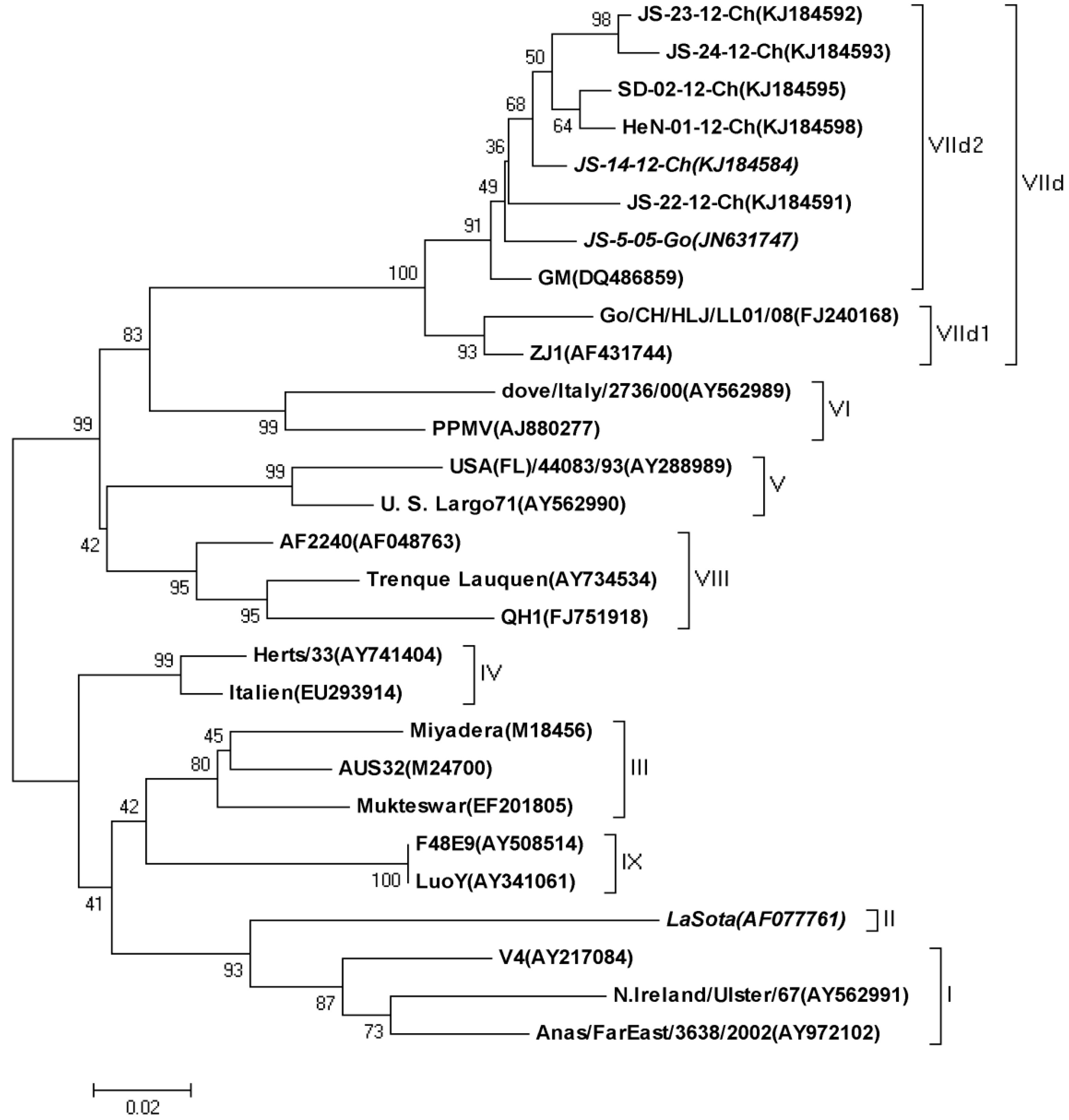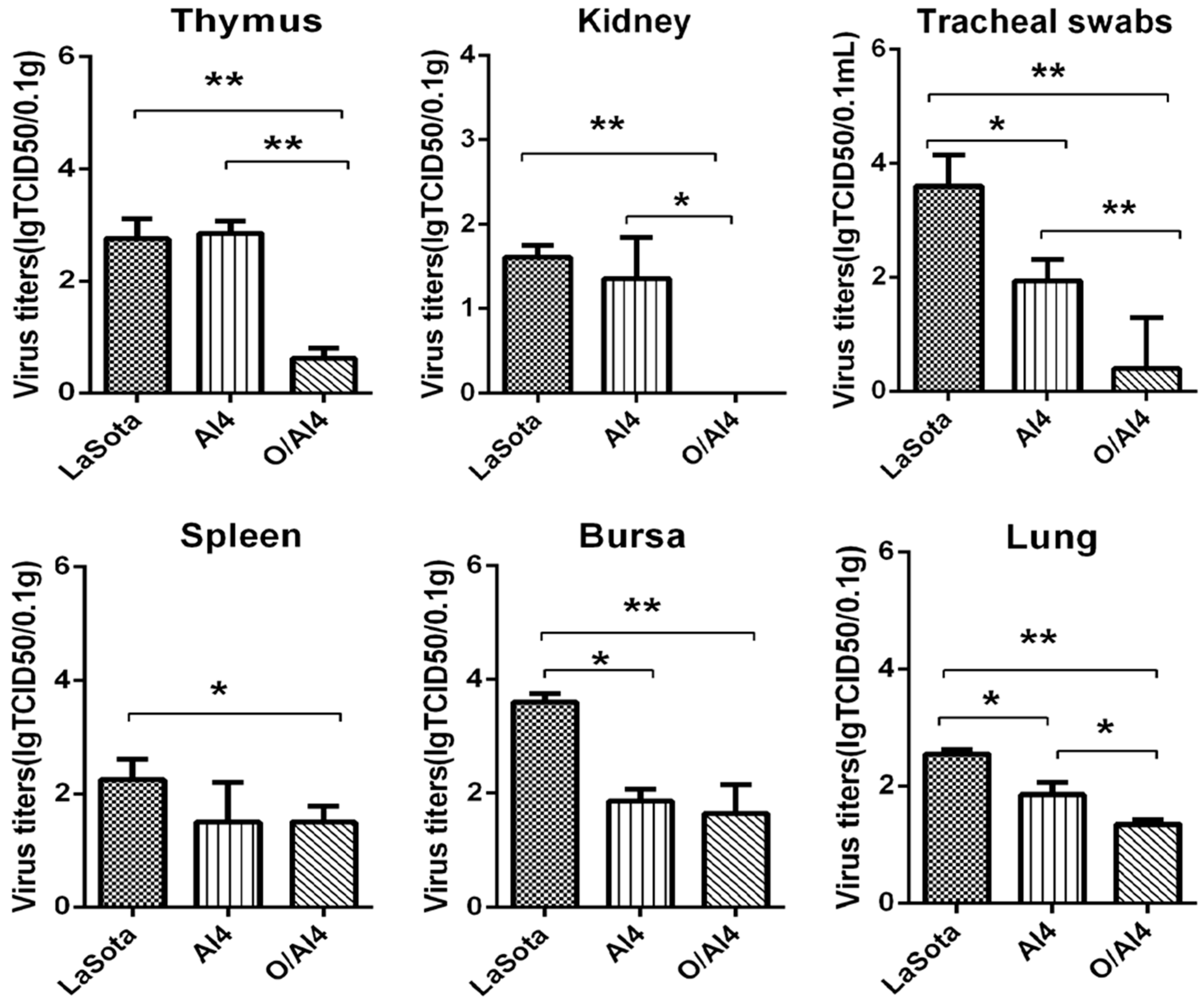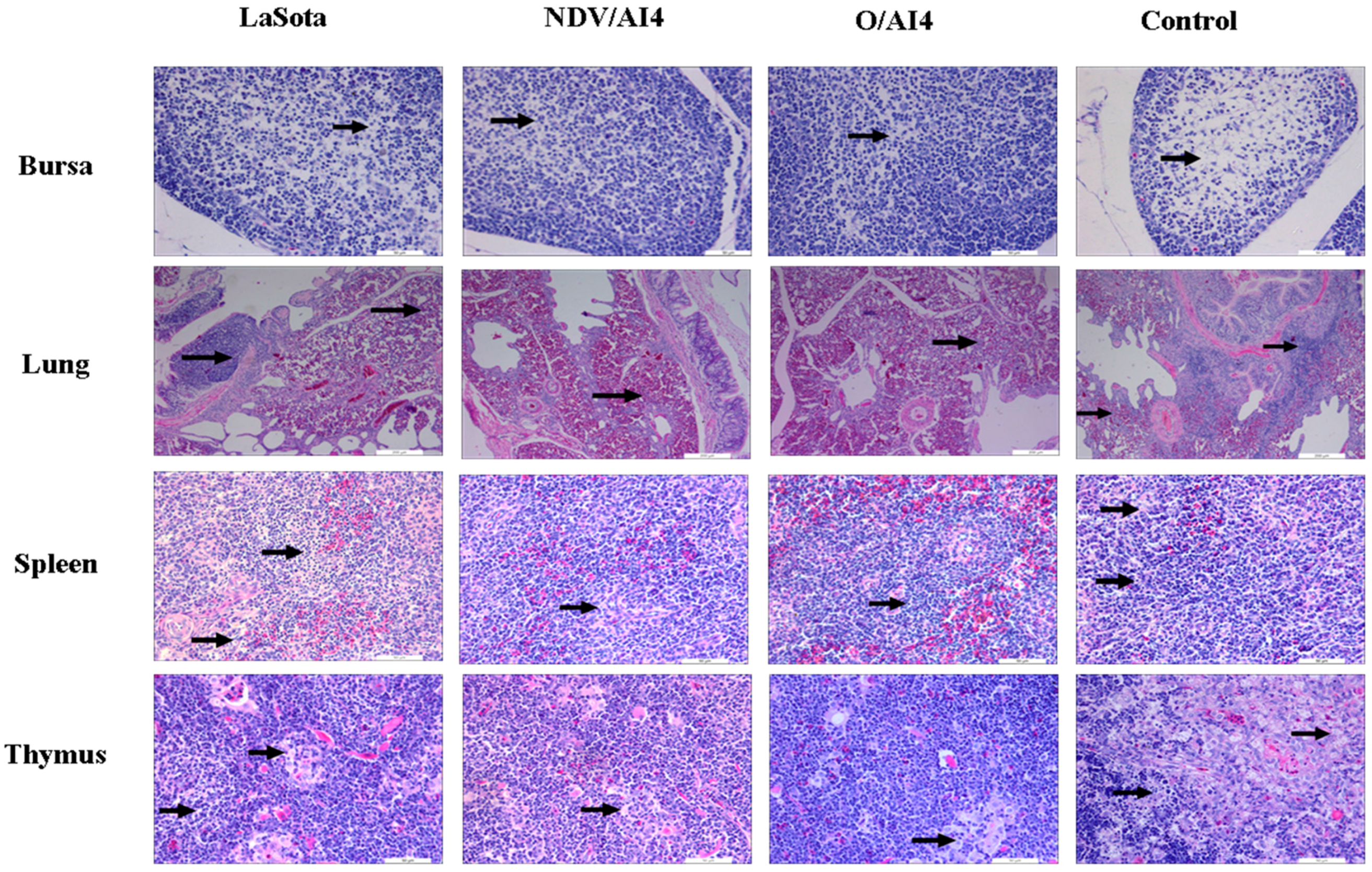Effects of the HN Antigenic Difference between the Vaccine Strain and the Challenge Strain of Newcastle Disease Virus on Virus Shedding and Transmission
Abstract
:1. Introduction
2. Methods
2.1. Ethics Statement
2.2. Cells, Plasmids and Viruses
2.3. Phylogenetic Analysis
2.4. Replacement of Hemagglutinin–Neuraminidase Gene of the Recombinant Virus NDV O/AI4 and Virus Rescue
2.5. Cross Hemagglutination Inhibition Test and Virus Neutralization Test
2.6. Preparation of Vaccines
2.7. Experimental Design
2.8. Statistical Analysis
3. Results
3.1. Phylogenetic Analysis
3.2. Recovery of the Recombinant NDV O/AI4
3.3. Cross Hemagglutination Inhibition (HI) Test and Antigenic Relatedness Analyse
3.4. Virus Shedding
3.5. Histopathology
4. Discussion
Acknowledgments
Author Contributions
Conflicts of Interest
References
- Alexander, D.J. Newcastle disease and other avian paramyxoviruses. Rev. Sci. Tech. 2000, 19, 443–462. [Google Scholar] [CrossRef] [PubMed]
- Cho, S.H.; Kim, S.J.; Kwon, H.J. Genomic sequence of an antigenic variant Newcastle disease virus isolated in Korea. Virus Genes 2007, 35, 293–302. [Google Scholar] [CrossRef] [PubMed]
- Choi, K.S.; Kye, S.J.; Kim, J.Y.; To, T.L.; Nguyen, D.T.; Lee, Y.J.; Choi, J.G.; Kang, H.M.; Kim, K.I.; Song, B.M.; et al. Molecular epidemiology of Newcastle disease viruses in Vietnam. Trop. Anim. Health Prod. 2014, 46, 271–277. [Google Scholar] [CrossRef] [PubMed]
- Kwon, H.J.; Cho, S.H.; Ahn, Y.J.; Seo, S.H.; Choi, K.S.; Kim, S.J. Molecular epidemiology of Newcastle disease in republic of Korea. Vet. Microbiol. 2003, 95, 39–48. [Google Scholar] [CrossRef]
- Umali, D.V.; Ito, H.; Suzuki, T.; Shirota, K.; Katoh, H.; Ito, T. Molecular epidemiology of Newcastle disease virus isolates from vaccinated commercial poultry farms in non-epidemic areas of Japan. Virol. J. 2013, 10, 330. [Google Scholar] [CrossRef] [PubMed]
- Wu, S.; Huang, W.; Wang, W.; Hu, S.; Wang, X.; Liu, X. Genetic variation analysis of subgenotype genetic variation analysis of subgenotype VIId Newcastle disease viruses isolated from Jiangsu Province in 2008. Acta Vet. Zootech. Sin. 2009, 40, 1782–1787. [Google Scholar]
- Dimitrov, K.M.; Afonso, C.L.; Yu, Q.; Miller, P.J. Newcastle disease vaccines—A solved problem or a continuous challenge? Vet. Microbiol. 2016, 206, 126–136. [Google Scholar] [CrossRef] [PubMed]
- Hu, S.; Wang, T.; Liu, Y.; Meng, C.; Wang, X.; Wu, Y.; Liu, X. Identification of a variable epitope on the Newcastle disease virus hemagglutinin-neuraminidase protein. Vet. Microbiol. 2010, 140, 92–97. [Google Scholar] [CrossRef] [PubMed]
- Hu, S.; Ma, H.; Wu, Y.; Liu, W.; Wang, X.; Liu, Y.; Liu, X. A vaccine candidate of attenuated genotype VII Newcastle disease virus generated by reverse genetics. Vaccine 2009, 27, 904–910. [Google Scholar] [CrossRef] [PubMed]
- Miller, P.J.; King, D.J.; Afonso, C.L.; Suarez, D.L. Antigenic differences among Newcastle disease virus strains of different genotypes used in vaccine formulation affect viral shedding after a virulent challenge. Vaccine 2007, 25, 7238–7246. [Google Scholar] [CrossRef] [PubMed]
- Dortmans, J.C.; Peeters, B.P.; Koch, G. Newcastle disease virus outbreaks: Vaccine mismatch or inadequate application? Vet. Microbiol. 2012, 160, 17–22. [Google Scholar] [CrossRef] [PubMed]
- Dortmans, J.C.; Venema-Kemper, S.; Peeters, B.P.; Koch, G. Field vaccinated chickens with low antibody titres show equally insufficient protection against matching and non-matching genotypes of virulent Newcastle disease virus. Vet. Microbiol. 2014, 172, 100–107. [Google Scholar] [CrossRef] [PubMed]
- Miller, P.J.; Afonso, C.L.; El Attrache, J.; Dorsey, K.M.; Courtney, S.C.; Guo, Z.; Kapczynski, D.R. Effects of Newcastle disease virus vaccine antibodies on the shedding and transmission of challenge viruses. Dev. Comp. Immunol. 2013, 41, 505–513. [Google Scholar] [CrossRef] [PubMed]
- Hu, Z.; Hu, S.; Meng, C.; Wang, X.; Zhu, J.; Liu, X. Generation of a genotype VII Newcastle disease virus vaccine candidate with high yield in embryonated chicken eggs. Avian Dis. 2011, 55, 391–397. [Google Scholar] [CrossRef] [PubMed]
- Cardenas-Garcia, S.; Afonso, C.L. Reverse genetics of Newcastle disease virus. Methods Mol. Biol. 2017, 1602, 141–158. [Google Scholar] [PubMed]
- Molouki, A.; Peeters, B. Rescue of recombinant Newcastle disease virus: Current cloning strategies and RNA polymerase provision systems. Arch. Virol. 2017, 162, 1–12. [Google Scholar] [CrossRef] [PubMed]
- Molouki, A.; Peeters, B. Rescue of recombinant Newcastle disease virus: A short history of how it all started. Arch. Virol. 2017, 162, 1845–1854. [Google Scholar] [CrossRef] [PubMed]
- Buchholz, U.J.; Finke, S.; Conzelmann, K.K. Generation of bovine respiratory syncytial virus (BRSV) from cDNA: BRSVNS2 is not essential for virus replication in tissue culture, and the human RSV leader region acts as a functional BRSV genome promoter. J. Virol. 1999, 73, 251–259. [Google Scholar] [PubMed]
- Della-Porta, A.J.; Spencer, T. Newcastle disease. Aust. Vet. J. 1989, 66, 424–426. [Google Scholar] [CrossRef] [PubMed]
- Li, Z.J.; Li, Y.; Chang, S.; Ding, Z.; Mu, L.Z.; Cong, Y.L. Antigenic variation between Newcastle disease viruses of goose and chicken origin. Arch. Virol. 2010, 155, 499–505. [Google Scholar] [CrossRef] [PubMed]
- Archetti, I.; Horsfall, F.L., Jr. Persistent antigenic variation of influenza A viruses after incomplete neutralization in ovo with heterologous immune serum. J. Exp. Med. 1950, 92, 441–462. [Google Scholar] [CrossRef] [PubMed]
- Wang, J.; Liu, H.; Liu, W.; Zheng, D.; Zhao, Y.; Li, Y.; Wang, Y.; Ge, S.; Lv, Y.; Zuo, Y.; et al. Genomic characterizations of six pigeon paramyxovirus type 1 viruses isolated from live bird markets in China during 2011 to 2013. PLoS ONE 2015, 10, e0124261. [Google Scholar] [CrossRef] [PubMed]
- Yang, H.M.; Zhao, J.; Xue, J.; Yang, Y.L.; Zhang, G.Z. Antigenic variation of LaSota and genotype VII Newcastle disease virus (NDV) and their efficacy against challenge with velogenic NDV. Vaccine 2017, 35, 27–32. [Google Scholar] [CrossRef] [PubMed]
- Cho, S.H.; Kwon, H.J.; Kim, T.E.; Kim, J.H.; Yoo, H.S.; Park, M.H.; Park, Y.H.; Kim, S.J. Characterization of a recombinant Newcastle disease virus vaccine strain. Clin. Vaccine Immunol. 2008, 15, 1572–1579. [Google Scholar] [CrossRef] [PubMed]
- Meng, C.; Qiu, X.; Jin, S.; Yu, S.; Chen, H.; Ding, C. Whole genome sequencing and biological characterization of duck/js/10, a new lentogenic class I Newcastle disease virus. Arch. Virol. 2012, 157, 869–880. [Google Scholar] [CrossRef] [PubMed]
- Huang, Y.; Yang, S.; Hu, B.; Xu, C.; Gao, D.; Zhu, M.; Huang, Q.; Zhang, L.; Wu, J.; Zhang, X.; et al. Genetic, pathogenic and antigenic diversity of Newcastle disease viruses in Shandong Province, China. Vet. Microbiol. 2015, 180, 237–244. [Google Scholar] [CrossRef] [PubMed]
- Zhu, J.; Hu, S.; Xu, H.; Liu, J.; Zhao, Z.; Wang, X.; Liu, X. Characterization of virulent Newcastle disease viruses from vaccinated chicken flocks in Eastern China. BMC Vet. Res. 2016, 12, 113. [Google Scholar] [CrossRef] [PubMed]
- Yuan, X.; Wang, Y.; Li, J.; Yu, K.; Yang, J.; Xu, H.; Zhang, Y.; Ai, H.; Wang, J. Surveillance and molecular characterization of Newcastle disease virus in seafowl from coastal areas of China in 2011. Virus Genes 2013, 46, 377–382. [Google Scholar] [CrossRef] [PubMed]
- Zhang, Y.Y.; Shao, M.Y.; Yu, X.H.; Zhao, J.; Zhang, G.Z. Molecular characterization of chicken-derived genotype VIId Newcastle disease virus isolates in China during 2005–2012 reveals a new length in hemagglutinin-neuraminidase. Infection, genetics and evolution. J. Mol. Epidemiol. Evolut. Genet. Infect. Dis. 2014, 21, 359–366. [Google Scholar] [CrossRef] [PubMed]



| Strains | R Value c | 345–353 Residues of HN |
|---|---|---|
| NDV/AI4 | 0.35 a, 0.35 b | PDKQDYQIR |
| O/AI4 | 0.7 a, 1 b | PDKQDYQIR |
| LaSota | 0.06 a, 0.12 b | PDEQDYQIR |
| Group | Vaccine | Antibody Titers (log2) | No. Swabs Positive in Virus Isolation/Total No. of at Days Post Challenge | |||||
|---|---|---|---|---|---|---|---|---|
| 3 dpc | 5 dpc | 7 dpc | ||||||
| T a | C b | T | C | T | C | |||
| LaSota | LaSota | 6 | 10/12 | 4/12 | 4/9 | 5/9 | 0/9 | 3/9 |
| AI4 | NDV/AI4 | 6 | 9/12 | 1/12 | 3/9 | 2/9 | 0/9 | 0/9 |
| O/AI4 | NDV O/AI4 | 6 | 4/12 | 0/12 | 2/9 | 1/9 | 0/9 | 0/9 |
| Control | PBS | 0 | 5/5 | 5/5 | - c | - | - | - |
| Organ | Group | |||
|---|---|---|---|---|
| LaSota | AI4 | O/AI4 | Control | |
| Bursa | ++ | + | + | +++ |
| Lung | ++ | + | + | +++ |
| Spleen | ++ | + | + | +++ |
| Thymus | ++ | + | + | +++ |
© 2017 by the authors. Licensee MDPI, Basel, Switzerland. This article is an open access article distributed under the terms and conditions of the Creative Commons Attribution (CC BY) license (http://creativecommons.org/licenses/by/4.0/).
Share and Cite
Liu, J.; Zhu, J.; Xu, H.; Li, J.; Hu, Z.; Hu, S.; Wang, X.; Liu, X. Effects of the HN Antigenic Difference between the Vaccine Strain and the Challenge Strain of Newcastle Disease Virus on Virus Shedding and Transmission. Viruses 2017, 9, 225. https://doi.org/10.3390/v9080225
Liu J, Zhu J, Xu H, Li J, Hu Z, Hu S, Wang X, Liu X. Effects of the HN Antigenic Difference between the Vaccine Strain and the Challenge Strain of Newcastle Disease Virus on Virus Shedding and Transmission. Viruses. 2017; 9(8):225. https://doi.org/10.3390/v9080225
Chicago/Turabian StyleLiu, Jingjing, Jie Zhu, Haixu Xu, Juan Li, Zenglei Hu, Shunlin Hu, Xiaoquan Wang, and Xiufan Liu. 2017. "Effects of the HN Antigenic Difference between the Vaccine Strain and the Challenge Strain of Newcastle Disease Virus on Virus Shedding and Transmission" Viruses 9, no. 8: 225. https://doi.org/10.3390/v9080225





